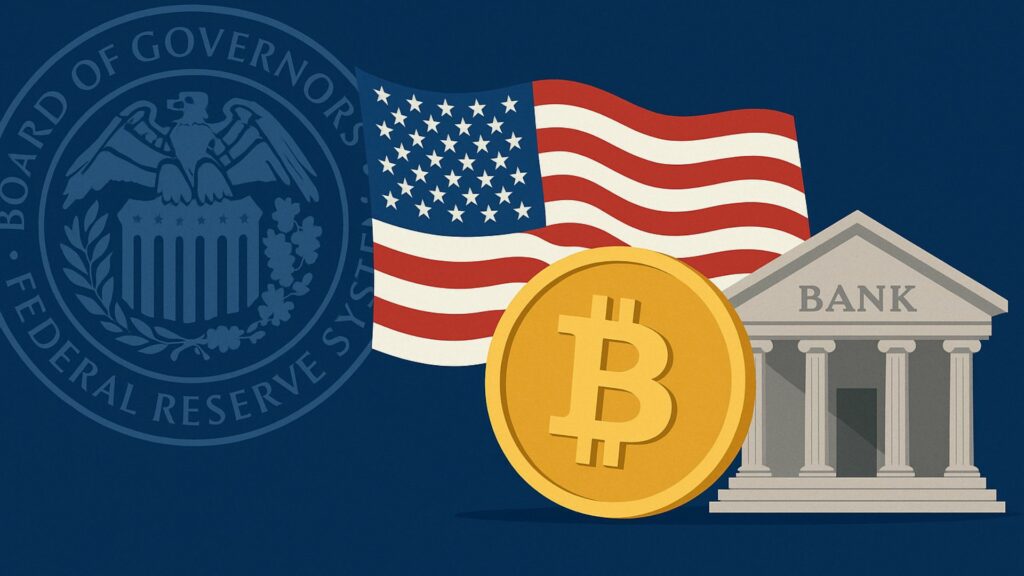The Federal Reserve has just removed one of the biggest roadblocks for banks looking to enter crypto. By revoking its 2022 directive, banks are no longer required to seek approval before launching crypto-related services.
This quiet policy shift means digital asset activities will now be monitored through standard supervision instead of special processes. The move could open the door to wider adoption, greater institutional involvement, and a new wave of bank-driven crypto products.
Can Banks Transact Crypto Freely Now?
Until now, any US bank planning to get involved in crypto had to notify the Federal Reserve in advance.
Whether they wanted to offer custody for digital assets, issue stablecoins, or experiment with blockchain infrastructure, they needed to go through a separate approval process. This made the rollout of crypto services slower, riskier, and filled with uncertainty.
With the 2022 rule now revoked, that hurdle has been removed. From now on, crypto will be treated just like any other area of banking.
Activities involving digital assets will fall under the Fed’s routine supervisory processes, meaning banks can launch or expand their crypto offerings without waiting for special clearance.
This shift also includes the withdrawal of two previous joint policy statements from 2023 that were issued with the FDIC and OCC. These statements outlined specific rules for banks dealing with crypto exposure and stablecoins. Their removal signals a broader regulatory reset.
It is important to note that this does not eliminate regulation. Banks still need to follow strict legal and compliance requirements, including those around risk management and consumer protection.
But instead of jumping through separate hoops for crypto, they can now move forward using the systems already in place for everything else.
For the banking sector, this provides a more level playing field. Crypto is no longer considered an exception, it is now part of the standard financial toolkit. And that could be the push some institutions have been waiting for.
What It Means for Crypto Adoption in the US
The most immediate impact of the Fed’s decision is increased freedom for banks to innovate. Without the need to ask for permission, they can now move faster to explore new services involving digital assets.
That might include letting customers buy crypto directly from their banking apps, offering secure digital wallets, or enabling faster cross-border payments using stablecoins.
Stablecoins in particular could see a surge in activity. Banks have been cautious around dollar-backed tokens due to the extra regulatory steps required.
Now that these activities will be reviewed through normal channels, the risk of regulatory delay or conflict has dropped. This makes it easier for institutions to integrate stablecoins into their operations, whether for settlements, remittances, or internal transfers.
The move may also attract banks that had previously stayed away from crypto altogether. Smaller and mid-sized institutions, which often lack the legal teams to navigate complex approval systems, may now find it easier to test crypto-based products.
This could help bring financial inclusion to customers who have not yet been served by existing digital asset platforms.
The wider adoption of crypto in banking also creates space for more serious investment in blockchain infrastructure.
With reduced uncertainty, banks may start to build systems that use decentralised networks for processing, tracking, or record-keeping. This could improve efficiency, cut costs, and help banks stay competitive in a digital-first economy.
On the customer side, trust could grow as well. Many users are still unsure about crypto due to its association with unregulated exchanges and unfamiliar platforms.
If their bank starts offering crypto products directly, people may feel more secure engaging with digital assets for the first time.
This change does not mean every bank will jump in immediately. Some may still take a wait-and-see approach. But the regulatory environment is now more supportive, and that alone could trigger the next phase of crypto growth inside traditional finance.
Conclusion
By removing the rule that forced banks to seek approval before entering crypto, the Federal Reserve has made a quiet but powerful statement. Banks can now move forward with fewer barriers, and crypto is one step closer to becoming a standard feature of financial services.
This change could accelerate innovation, drive broader adoption, and reshape the relationship between banks and digital assets for years to come.

